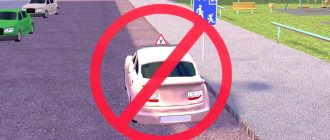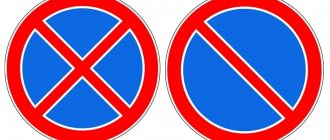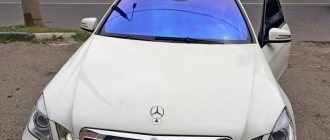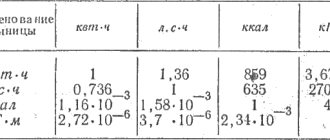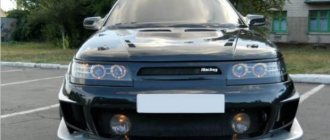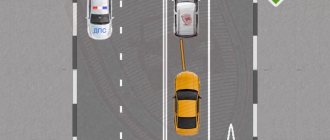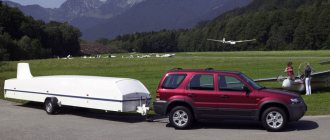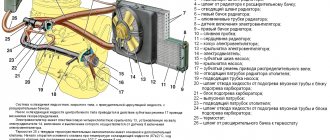Definition of reverse movement
Reversible traffic is a special mode of traffic organization in which vehicles at different periods of time can move along special reversible lanes, both in one direction and in the opposite direction. Such lanes are marked with special signs and road markings, and traffic on these lanes is regulated by reversible traffic lights.
Malyshev Sergey Petrovich
Major of the traffic police special regiment for St. Petersburg
Ask a Question
Reversible lanes are usually used to avoid traffic congestion at different times.
For example, in the morning, many people go to work from the suburbs to the city - in this case, it is beneficial to allocate an additional lane for them, and in the evening these people will return home - then it will be reasonable to change the direction of travel to avoid traffic jams.
Reversible traffic light, what is it?
Every driver has heard about the term “reverse movement”. However, not everyone has encountered it in reality. Reversing movement is often used at a certain period of time when it is required.
The need for these lanes arises on those sections of roads where traffic intensity changes throughout the day. So, for example, in the morning everyone rushes from home to work, and in the evening, vice versa. And in order to avoid hours-long traffic jams, special lanes are being introduced.
Traffic regulation is carried out by means of a traffic light, a traffic police officer or road workers. A reversible traffic light controls traffic in the lane above which it is located.
Sometimes these traffic lights are used in tunnels. Installed above the rows, they make it possible to regulate traffic on the lanes in a short period of time during road accidents or during repair work on the roadway.
Reverse traffic rules
There are two main types of traffic organization on such roads:
- If the reverse stripe is marked on both sides with special markings, which look like two wide broken white lines. In this case, movement must be carried out according to traffic lights according to the general rules. After leaving the lane, the driver must change lanes to the right of the reverse lane.
- If there is a special marking in the middle of the road, which looks like two wide broken white lines. In this case, two lanes can be used for reverse traffic, which are located to the right and left of this marking. It should be understood that traffic on such lanes in the presence of traffic lights is carried out only in one direction.
Malyshev Sergey Petrovich
Major of the traffic police special regiment for St. Petersburg
Ask a Question
For example, there is a road with 4 lanes, and in the middle of the road there is a special marking indicating the presence of reverse traffic, in which case 3 lanes will be used for traffic in one direction. If there are markings, but the traffic lights are not on (there is no permissive or prohibiting signal), then traffic is carried out in the usual direction (in the case of our example, 2 lanes will be used for traffic in one direction, 2 other lanes will be used for traffic in opposite direction).
Ways to indicate reverse movement
The traffic rules provide for three types of reverse traffic designation: information and indication sign; reversible traffic light; special markings.
- Reversing sign
It is a white vertical stripe with two arrows at the ends, which is applied to a blue rectangular field with a white rim along the edge. This sign is similar in appearance to the “Go straight” sign, so it is extremely important not to confuse it while driving, as such a mistake can lead to dire consequences. - Reversible traffic light Designed to regulate traffic in a reversible lane. It is installed immediately before the start of the lane and signals the possibility or prohibition of movement in a certain direction.
- Marking complements the sign and consists of two or more double interrupted stripes that are located parallel to each other. The length of the gaps between the stripes is 1/3 of the drawn strip.
How is the reversible lane indicated in the video:
Reversing signs
There are 3 specialized road signs:
- White arrow with two tips that are directed in different directions. This sign indicates that a reversible lane begins ahead.
- The same sign, which is crossed out diagonally by a wide red line. This sign indicates that the reversible lane is about to end.
- The same sign as the first one, but the arrow is positioned horizontally. This sign indicates that a reversible lane begins ahead, and the lane itself will be perpendicular to the current traffic (usually this sign is placed before an intersection with reversible traffic).
Fines
If the reverse traffic rules are not followed, a fine will be imposed on those responsible.
How poor the driver’s wallet will be depends on the specific circumstances of his offense:
- 500 rubles - violation of the rules for changing lanes when leaving the reverse lane;
- 1000 rubles - failure to comply with traffic light instructions;
- 5000 rubles - entering the lane when the traffic light is not working.
You should not hope that the matter may be limited to a fine.
The court has the power to deprive a traffic hooligan of his driver's license if he puts the lives of other road users at risk. With all the convenience of reverse movement, you need to understand that if on your side the traffic light is turned off or out of order, then on the other end its analogue can work and allow movement towards you.
To avoid problems with the law while driving in reverse, you need to carefully study the rules of the eighth section of the Road Traffic Regulations and be as focused as possible on the road. If you follow all the rules during reverse movement, this will not only not worsen your financial condition, but will also prevent emergency situations. Only vigilance on the road can protect the driver from unwanted consequences.
Marking during reverse movement
Reversible lanes are located in the center of the road. This strip has special road markings, which look like two wide broken white lines.
Often this road is marked with special signs that indicate to the driver that there will be a section of road with reversible traffic ahead.
Unfortunately, in many cities these signs are not installed, which complicates traffic, since in winter the markings may be covered with snow.
Reverse traffic light operation
Traffic on such sections of the road is regulated by a special reversible traffic light. This special traffic light is installed above each reversible road and regulates traffic only in its lane.
Malyshev Sergey Petrovich
Major of the traffic police special regiment for St. Petersburg
Ask a Question
If on any section of the road there are several lanes with reversible traffic, then traffic regulation is carried out using the appropriate number of traffic lights. A reversible traffic light usually contains 2 or 3 segments, where only one segment can be lit at a time: - the “green arrow pointing down” segment is lit - this signal indicates that you can enter the reversible lane; — the “red cross” segment is lit - this signal indicates that you cannot enter the reverse lane (if the driver does this, he will be fined);
- the segment “yellow arrow directed diagonally to the right and down” is on - this signal indicates that the direction of movement will soon change on the reverse lane, so the driver must change lanes to the right.
Reversible traffic light signs
As already mentioned above, a reversible traffic light is presented in the form of signs that permit and prohibit movement in the reversible lane.
A traffic light signal shaped like the letter “X” in red prohibits driving in the reverse lane, since at this time cars are moving in the opposite direction. When such a signal is operating, any movement on the roadway is prohibited, including entering a regular lane. Since if this rule is violated, there is a threat of creating an emergency situation and, as a result, blocking a certain section of the road.
There is also a sign depicted as an arrow directed diagonally to the right or left corner of the square. If such a sign works, this means that the driver has the right to change lanes from one road lane to another, and in the exact direction in which the arrow points. Typically, such a sign also indicates a change from a prohibiting signal to a permissive one and vice versa, soon. It should be borne in mind that, unlike a regular traffic light, a yellow signal does not prohibit movement, but gives the opportunity to change lanes until another traffic light turns on. At the same time, changing lanes is your right, not your obligation. That is, it is not prohibited to continue driving in the reverse lane after the traffic light changes to green.
Permitting movement on the reverse lane is a signal represented as a green arrow pointing upward. When such a signal is working, you can move along the reverse lane without fear, but you should remember that the reverse traffic light only regulates traffic in the reverse lane and does not extend its effect to the rest of the road space. While such a signal is operating, it is also prohibited to change the car into another lane.
Penalty for violation of reverse movement
For failure to comply with traffic rules, the driver may be fined:
- if the driver does not change lanes to the right when leaving the reverse lane, he will be fined 500 rubles;
- if the driver of the vehicle ignored the traffic light signal, he will be fined 1,000 rubles;
- if the traffic light was turned off, the driver drove onto a road with reverse traffic, and the offense itself was committed for the first time, then the driver of the vehicle will be fined 5,000 rubles ; at the same time, the reversible lane is marked on both sides with special road markings, which look like two wide broken white lines (in fact, such movement is equivalent to driving in the oncoming lane);
- if the traffic light was turned off, the driver drove onto a road with reverse traffic, and the offense itself was not committed for the first time, then the driver will be deprived of his driver’s license for up to 1 year; at the same time, the reversible lane is marked on both sides with special road markings, which look like two wide broken white lines; the same rule applies here - in fact, such movement is equivalent to driving in the oncoming lane.
You can watch this video to learn more about reverse motion.
Now you know how reverse movement works. Let's summarize. Traffic on reversible lanes is regulated by special traffic lights, and the very presence of such roads is marked with special signs and markings. There is a fine for violating the rules for driving on reverse lanes.
Responsibility for incorrect movement on a section with reverse
There are no special penalties for violators of reverse traffic rules in the rules and the Code. And negligent motorists are punished based on each specific case:
- Violation of the rules for leaving the lane will cost the driver 500 rubles;
- entering a lane with a broken traffic light is punishable by as much as 5,000 rubles; and in case of relapse - deprivation of driver's license for a year;
- ignoring traffic light instructions when entering a road with reverse traffic – 1000 rubles;
-for incorrectly positioning your car at an intersection you will be fined 1,500 rubles.
Even residents of small towns where you won’t find reverse traffic must know the main features of moving on roads with this type of traffic. Because all sorts of circumstances happen in life, and you cannot know for sure that you will not encounter it in the future.

